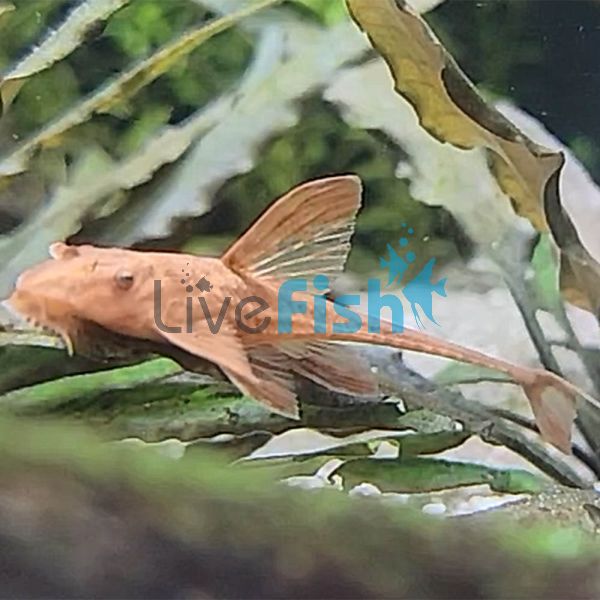Red Whiptail 5cm
The Red whiptail is a species that has developed a strong cult following, especially in the planted aquarium world. These fish make for a great alternative to the smaller and more drab ottocinclus but also don’t get as large as plecos which makes them a perfect middle ground for the clean-up crew. Red whiptails are also great oddball fish that only reach around 11 cm making them perfect to add into smaller aquariums just as an element of allure or to try out as a breeding experiment.
- Buy 5 for $71.72 each and save 10%
- Buy 10 for $63.75 each and save 20%
Red Whiptail
The Red whiptail is a species that has developed a strong cult following, especially in the planted aquarium world. These fish make for a great alternative to the smaller and more drab ottocinclus but also don’t get as large as plecos which makes them a perfect middle ground for the clean-up crew. Red whiptails are also great oddball fish that only reach around 11 cm making them perfect to add into smaller aquariums just as an element of allure or to try out as a breeding experiment.
Red whiptail catfish are easily in the top 10 list of oddball fish because they honestly don’t look real. Even when they feel threatened these fish will tend to have no movement to resemble a twig in the water. They have quite slender bodies that narrow into basically a stick for the tail whilst having a flat underbelly. Their body colour is a rusty orange from head to tail especially once matured, as juveniles though these fish tend to have a more camouflage look with darker orange striped and bands of white. Amongst botanicals and leaf litter in the aquarium, these fish look almost invisible. The red whiptail is a naturally occurring species from South America that prefer softer water with a PH range of 6.0-7.0 and a temperature range of 24-28 degrees.
Trying to find the males and females in this species can be a challenge as males and females both grow bristles on the side of their faces. They can also only tend to reach maturity at around 8-9 cm so these will for sure be a long-term breeding project. The best method to breed these fish is to put a group of 5-6 individuals into a tank and let them naturally pair off and spawn. The eggs can be removed and artificially raised however most aquarists wait until the eggs hatch naturally as the male tends to guard the spawn. Once the eggs hatch, the fry can be moved to a grow-out system.
Tank Recommendations for your Red Whiptail
Red whiptails are a species that only gets to 11 cm and has a very thin profile. The ideal aquarium for a group of these fish would be around 70 liters and it can be an incredibly simple and cheap system to run. These fish will be perfectly fine on a bare bottom system with some pleco caves, and an abundance of driftwood, and the aquarium can be filtered through some basic sponge filters. They will however also love a densely planted system with no problems at all. This species is most active when the lights are turned off.
Suitable Tank Buddies
The long nose whiptail catfish is extremely peaceful with aggression only ever coming out during breeding between males but this is always harmless bickering. These reclusive species will get along with a wide range of community fish.
Usually Compatible
Tetras, gouramis, Corydoras, angelfish, barbs dwarf cichlids such as rams, and large peaceful cichlids such as geophagus.
Sometime Compatible
Fin-nipping species like banded leporinus and small schools of tiger barbs should be avoided as they can make short work of the streamer-like extensions on the red whiptails. This can lead to infection and unwanted stress for the catfish.
Rarely Compatible
Large aggressive species such as African cichlids, Oscars, and Jaguar cichlids. These species may try to eat the whiptail which could end in death for both fish. Because of the dense bone and armour plating the whiptail often gets lodged in the predator fish’s throat.
Feeding your Red Whiptail
Red whiptails will easily take to a wide range of food and are arguably one of the easiest fish to feed. They are regarded as ‘wood eaters’ meaning they can easily sustain themselves eating aquarium driftwood. The best type of wood is Malaysian bog wood as this is a softer type and breaks down fairly easily. Do keep in mind that whiptails feeding exclusively on wood can lead to a lot of wood dust floating around in the water so some added mechanical filtration may be required.
Aside from this they will eat algae and decaying plant matter but will also eat sinking aquarium foods like sinking pleco wafers. This can be supplemented with blanched veggies like zucchini and pumpkin.
| Scientific Name | Rineloricaria Sp |
|---|---|
| Care Level | Easy |
| Common Names | Red Whiptail, Red Lizard Whiptail |
| Diet | Omnivore |
| Fish Family | Loricariidae |
| Lifespan (years) | 10 |
| Max. Length (cm) | 11 |
| Min. Tank Volume (l) | 70 |
| Origin | South America |
| Reef Safe | Yes |
| Sociability | Peaceful |
| Venomous | No |
| Water Conditions | 24-26° C, pH 6.0-7.0 |




